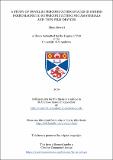Files in this item
A study of novel superconducting states in hybrid ferromagnetic-superconducting metamaterials and thin film devices
Item metadata
| dc.contributor.advisor | Lee, Stephen | |
| dc.contributor.author | Stewart, Rhea | |
| dc.coverage.spatial | vii, 187 p. | en_US |
| dc.date.accessioned | 2019-11-20T11:49:08Z | |
| dc.date.available | 2019-11-20T11:49:08Z | |
| dc.date.issued | 2019-12-03 | |
| dc.identifier.uri | https://hdl.handle.net/10023/18956 | |
| dc.description.abstract | In hybrid mesoscopic systems the Meissner response of a superconducting film can be very different from its bulk behaviour. For instance, in normal (N) superconductor (S) bilayers screening can be greatly enhanced depending on the relative material properties and interface conditions. Furthermore, with the addition of ferromagnetic (F) layers comes the possibility of generating a paramagnetic screening response due to spin triplet pairs. Such pairs are produced from the mixing of opposing microscopic orders within S (which conventionally hosts electron pairs of opposite spin and momenta) and F (inside which spin symmetry is broken). The net result is a conversion of a fraction of the pairs to an odd-frequency s-wave triplet state. Any resultant modifications to the screening manifest in the flux profile across a sample which is directly probed using low energy muon spin rotation (LEμSR). Results of LEμSR experiments involving layered systems comprised of N, S and F elements are presented within chapter 3. A discrepancy between the pre-existing quasiclassical theory and measured flux profiles in the presence of an F layer was observed. A large enhancement to the flux lowering which could not be interpreted within the traditional S/F proximity picture was found. New theoretical developments have since suggested that coupled to direct electronic proximity effects within these systems is an additional electromagnetic component. Chapter 4 presents the results of analysing LEμSR data using a spatial flux profile consistent with new theory. In doing so, the observed anomalous enhancement could be successfully reconciled with the electromagnetic proximity effect. Subsequent experimental work in chapters 4 - 6 sought to test the main predictions of the theory by manipulating S/F interfaces within a variety of different structures. In all tested cases the theory provided an excellent description of experiment suggesting the importance of considering electromagnetic effects within S/F hybrid systems. | en_US |
| dc.description.sponsorship | "The work presented in this thesis was financially supported by the University of St Andrews and the Scottish Doctoral Training Centre in Condensed Matter Physics under EPSRC grant number: EP/L015110/1. Additional funding for experiments and related equipment was received from the following EPSRC grant numbers: EP/I031014/1, EP/J010634/1, EP/R031924/1, EP/R023522/1 and EP/L017008/1." -- Funding | en |
| dc.language.iso | en | en_US |
| dc.publisher | University of St Andrews | |
| dc.rights | Creative Commons Attribution-NonCommercial-NoDerivatives 4.0 International | * |
| dc.rights.uri | http://creativecommons.org/licenses/by-nc-nd/4.0/ | * |
| dc.subject | Condensed matter physics | en_US |
| dc.subject | Superconductivity | en_US |
| dc.subject | Ferromagnetism | en_US |
| dc.subject.lcc | QC173.458E43S8 | |
| dc.subject.lcsh | Condensed matter | en |
| dc.subject.lcsh | Superconductivity | en |
| dc.subject.lcsh | Ferromagnetism | en |
| dc.title | A study of novel superconducting states in hybrid ferromagnetic-superconducting metamaterials and thin film devices | en_US |
| dc.type | Thesis | en_US |
| dc.contributor.sponsor | Engineering and Physical Sciences Research Council (EPSRC) | en_US |
| dc.contributor.sponsor | University of St Andrews | en_US |
| dc.contributor.sponsor | Scottish Doctoral Training Centre in Condensed Matter Physics (CM-CDT) | en_US |
| dc.type.qualificationlevel | Doctoral | en_US |
| dc.type.qualificationname | PhD Doctor of Philosophy | en_US |
| dc.publisher.institution | The University of St Andrews | en_US |
| dc.identifier.doi | https://doi.org/10.17630/10023-18956 |
The following licence files are associated with this item:
This item appears in the following Collection(s)
Except where otherwise noted within the work, this item's licence for re-use is described as Creative Commons Attribution-NonCommercial-NoDerivatives 4.0 International
Items in the St Andrews Research Repository are protected by copyright, with all rights reserved, unless otherwise indicated.


